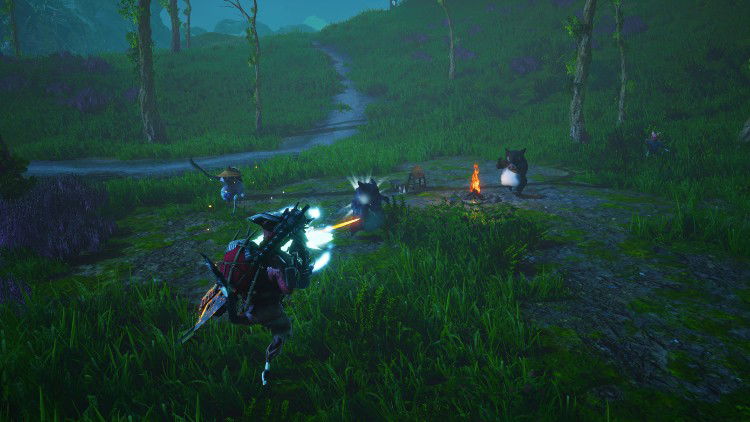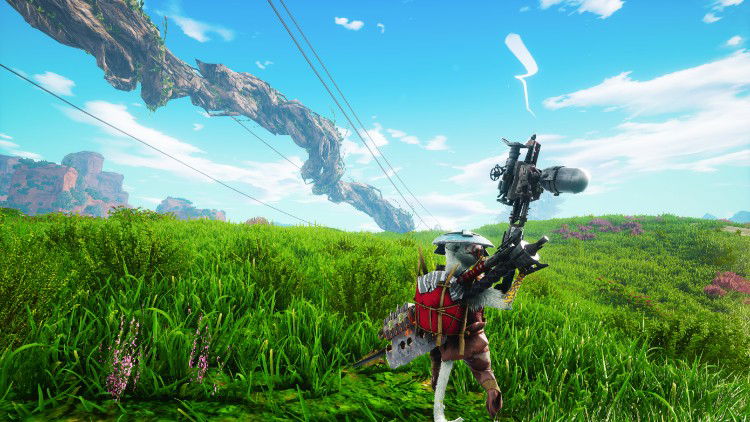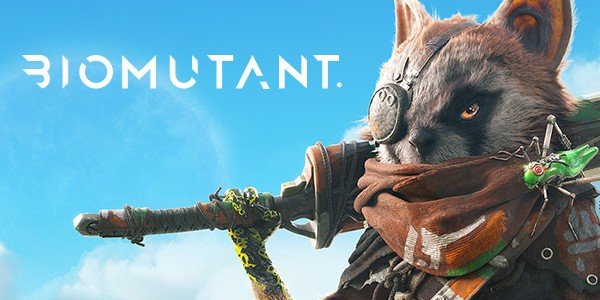Back in 2017, a new development studio was formed by the name of Experiment 101. Biomutant, the studio’s first game touted as a post-apocalyptic fable announced soon after the studio was formed and then, the game faded into obscurity. As time passed, very little was revealed about the game as it was hit by delay after delay. However, four years later, on January 26th, THQ Nordic and Experiment 101 gave us a release date, and as we closed in on May 25th, I did my best to consume as much information about the game as possible. I read and watched the previews, then dove headfirst into the reviews. Needless to say, I was very excited that I was finally going to get my hands on the game. After around thirty hours of gameplay, I feel like I can finally talk about my experience with Biomutant.
Game Name: Biomutant
Platform(s): Reviewed on Xbox Series X, Also on PS4, PS5, Xbox One, PC
Publisher(s): THQ Nordic
Developer(s): Experiment 101
Release Date: May 25th, 2021
Price: $59.99
Wung-Fun and the way of the mutated claw
Combat is where I feel most conflicted with the game, and it is hard to discuss because while I did find it fun, it is not without its problems. In the world of Biomutant, your character is a student of a style of combat known as “Wung-Fu.” As you level up, you will unlock new attacks and perks to strengthen your weapons and character. The more Wung-Fu abilities you unlock will allow players to develop some wicked and flashy combinations that build up to activate your super Wung-Fu attacks, a timed state where you can unleash some serious pain on your enemies. While I took comfort in dual-wielding one-handed swords and firing at enemies with a handcraft auto-file, there is also a wide selection of psionic abilities and mutations players can always choose from as well. Mutations and Psi abilities do not contribute to your super Wung-Fu, but they are fun to use in a pinch. One moment that comes to mind is when I threw down a set of mushrooms using the “Fungi” ability and watched it bounce and between them, effectively removing the monster from the fight until the ability worn off.
Now, the issue I had with the combat is that it just feels weightless. More times than not, I found myself wondering if my attacks were connecting with my enemies. The sound effects that play during battle do not offer much of an indicator either as they sound low budget and seem to play regardless of whether you are hitting an enemy or not. There are also elemental effects that can be applied to enemies. Yet, the fire elemental effect is the most disruptive element as it sends enemies sprinting off in random directions, which can make landing your Wung-fu attacks even more of a chore. The lack of a lock-on system makes targeting enemies difficult and feels random when enemies all try to stand within the same spot, and your character struggles in trying to lock on to the one you want a the time. Then, there are the bugs. It was often that inputting the correct commands would not trigger my Wung-Fu abilities, or my character would get stuck on something in the environment during an attack, sometimes rendering my Super Wung-Fu useless.

Explore, Loot, Craft, Repeat: Starring Ratty Cruise
Exploration is one of the moments where Biomutant absolutely shines. I played the game on the Xbox Series X and found the world to be wonderful. Despite some small framerate hiccups here and there while riding around between biomes. The map is huge, but it feels like a lot of love went into detailing its “life after the post-apocalypse” world. Its various biomes, some of which you’ll need high resistances to explore fully, are full of things to do and stuff to find. You’ll often come across the ruins of the human world and the villages of those who currently inhabit it, each coming with their own checklist of things to do that reward players in giving them experience, loot, and the occasional stat-boosting “Old World Gadget.” Sometimes you’ll find puzzles, which weren’t particularly challenging. Interestingly enough, several puzzles are 90% finished for you and only take a bit of tweaking. If you’re looking for fun puzzles, then Biomutant isn’t going to provide you with that. I did notice that enemies don’t respawn so roads repeatedly traveled will eventually start to feel a little lonely after a while unless you’re the kind of gamer that enjoys a long peaceful ride.
Loot in Biomutant works a little differently than you may expect it to in comparison to other games. Chests and various versions of chests are scattered throughout the world, and looting them will usually provide players with healing items, boosters, crafting materials, and a variety of armor. The armor in the game consists of five pieces to cover your character’s head, face, torso, legs, and a backpack that all provide various bonuses to some of your stats. The downside to armor is that, to me, it felt more like fashion over function. The cooler-looking armor pieces were usually the weaker armor pieces I found and did not have much room for add-ons if any at all. If I did not want my character to look like a walking trashcan with a robotic raccoon head, I had to make sacrifices.
Where melee and ranged weaponry is concerned, you will not just loot them from any random mutated creature that wants to take you on. Instead, you must earn them through exploration, taking down rival tribes, and best of all, crafting them. The crafting system in Biomutant is fun, wild, and insanely useful. I chose to create a mercenary who came pre-installed with your run-of-the-mill dual katanas, and with the aid of the crafting system, I was able to carry those babies through a large portion of the game. I was constantly looting armor and recycling it down into materials to slap on wacky attachments or new hilts and blades. While I modified my melee weapons, I created many guns and came up with some fun ranged weapons. There came the point where I felt a bit like Doctor Frankenstein, and my arsenal of weaponry and patchwork sets of armor became my little monsters. I constantly took bits and pieces out to put in something new, like the tanto I attached a chainsaw to.
A story told in too many parts
If you’re wondering by now why I haven’t talked about the story, then I say worry no longer my friends, I saved the worst part (or parts) for last. In Biomutant, humans have wiped themselves off the map, making way for new life to blossom across the world. You’ll select one of these new lifeforms and create your own character and embark on a journey to save this new world, one way or the other, from its many problems. For starters, four titanic creatures are eating away at the root of a massive tree known as the “World Tree.” If that wasn’t bad enough, six factions are fighting over how to deal with the problem while you’re being pursued by a monster that massacred your village. Oh, and then there’s an Ark that only fits like six people in it because it’s the end of the world. Maybe. It depends on what you decide to do as if it matters.
Another of Biomutant’s downsides is that your choices never feel like they matter in any major way. There were at least two side quests that I did and brought a small aesthetic change to the world, which was one of the things I wish Experiment 101 tried to capitalize on more. Nothing I did had any impact on the world around me, despite there being a karma system. In my time on Twitter, THQ Nordic responded to me one time, telling me that the choices weren’t always black and white. It was a detail that I often heard in other videos and read about the game, but I can now safely say that the Karma system is just a generic black and white choice system. Far too often was I presented with the choice to kill a small creature or murder a helpless soul.
It’s also a limited system in that if I came across a burning village, I wasn’t given the option to take part in the raid. I could only save it and help in the rebuilding process. Granted, that was an interesting side quest to be a part of, yet it is one of the things that makes the “choice and karma” system feel more like an afterthought. When it comes to the tribe war, it’s death or unity. Where the World Eaters were concerned, I had to kill them. There was no alternative. Lupa-Lupin, the creature that massacred my village and killed my family? Do I need to tell you what the choices are with that one? I would argue that the only good thing to come out of the karma system is the karmic figures that occasionally appear. I did love the arguments between the devil and angel that pop up on your shoulders during the more major decisions. Those guys are cute.
Except for the narrator and your karmic figures, no one speaks a language that is known to man. Instead, the story is delivered via the narrator, who is also your translator and someone you will either enjoy or just flat out loathe (by the end, it will probably be the latter). For story purposes, the narrator gets the job done, and I really think they chose a man with the right voice. HOWEVER, this guy pipes in randomly and at all times of the game. It does not matter what you are doing, he usually has something to say, and they did not record that many lines with him, so you can expect to hear the same lines, over and over. There is an option to tone down the narrator and the gibberish spoken, but I never noticed it doing anything unless I set it to zero, which silenced the karmic characters.

Before we go
There are some other minor issues I wanted to toss out before ending this review. First off, I’m not a huge fan of the way the game handled the create-a-character. Instead of giving players the option to use sliders, you have to use this wheel, making it nearly impossible to make out what you’re selecting, especially when allotting your stat points. I also wish there were more variety between the playable races instead of every option coming off as some rodent hybrid. Abilities that aid in traversal and mounts don’t really feel that useful.
Mounts do not feel that fast, and the glider your automaton can unlock plummets instead of glides. I found the glider only useful for traversal off higher grounds. Lastly, there is the sound design, which I have already mentioned how sounds play at random during combat, but the ambient music is just as sporadic, turning off and on randomly. In one village I visited, the game would switch between two songs depending on if I entered or exited a building. It would just turn one song off, instantly start up another, and it was jarringly noticeable.
Despite all its faults, however, I enjoyed almost every minute I spent with Biomutant, even though there are plenty of mechanics I would love to see expanded on. I applaud Experiment 101 and recognize the small team that created such a fun open-world experience with a unique premise. However, it is a game that does not reach its full potential despite having rather sturdy bones. While the crafting system is top-notch, and it is easy to get lost within the game’s beautiful world, repetitive gameplay, an intrusive narrator holds the game back, and weightless combat. After saying that, I would like to end this review of Biomutant by saying this: sturdy bones make for interesting sequels. Hint, hint THQ Nordic.
Summary
Despite its many flaws, Biomutant remains a fun game with a study set of bones that might pay off in future titles should THQ Nordic give developer, Experiment 101 the green light to revisit their post-apocalyptic, kung-fu epic in a future sequel. As of right now, it might not exactly be worth full price until it receives some TLC.
Pros
- Fantastic crafting system.
- The beautiful world is fun to explore.
- Plenty of content.
- Combat is enjoyable at times
Cons
- The combat also lacks weight
- Generic choices and karma system.
- Someone stop the narrator.
- Major story plots never pay off.
- lackluster create-a-character.







